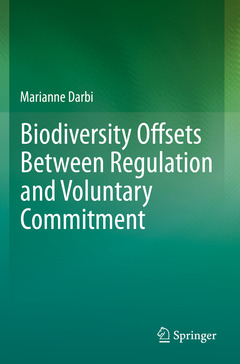Biodiversity Offsets Between Regulation and Voluntary Commitment, 1st ed. 2020 A Typology of Approaches Towards Environmental Compensation and No Net Loss of Biodiversity

We are witnessing an alarming, global biodiversity crisis with an ongoing loss of species and their habitats. In response, a number of tools and approaches ? including some that are contested ? are being explored and promoted. Biodiversity offsets are one such approach, and deserve critical examination since the debate surrounding them has often been oversimplified and lacking practical evidence. As such, this study presents a refined typology including seven types of biodiversity offsets and taking into account different contexts, governance arrangements and drivers. It draws on a detailed analysis of theoretical concepts to explain the voluntary implementation of biodiversity offsets using an internet-based (netnographic) research approach. Furthermore it builds on a broad global explorative base of 72 practical examples and presents in-depth case studies for each type. The results reveal a number of global tendencies that allow recommendations to be made for different locations, contexts and stakeholders. They also encourage the expansion of this research field to respond to the pressing needs of policy and practice.
Marianne Darbi is an environmental planner and researcher with many years of experience in landscape and spatial planning. After studying at the Technische Universität Dresden (Germany) and École d'Architecture et de Paysage de Bordeaux (France), she graduated in landscape architecture in 2007 and worked at the Leibniz Institute of Ecological Urban and Regional Development (Dresden) until December 2016. Since January 2017, she has been working as a postdoctoral researcher at the Department of Conservation Biology at the Helmholtz Centre for Environmental Research (Leipzig).
Marianne’s research focuses on biodiversity conservation and management as well as the mitigation of environmental impacts in the national and international context, sustainable land use, green economy and market-based instruments. Her PhD on Voluntary Bioversity Offsets at the Technical University of Dresden was awarded the Study Prize of the German Environmental Impact Assessment Association in 2016.
Her work has two major aims: 1) networking biodiversity research across disciplines (interdisciplinary) and 2) making knowledge relevant and transferable for decision making (science-policy interface). Marianne has advised institutions such as the European Commission, the Business and Biodiversity Offsets Program, the German Federal Ministry for the Environment, the German Federal Agency for Nature Conservation and KfW among others. Furthermore, she has worked with various NGOs and the private sector.
Date de parution : 08-2021
Ouvrage de 341 p.
15.5x23.5 cm
Date de parution : 05-2020
Ouvrage de 341 p.
15.5x23.5 cm
Disponible chez l'éditeur (délai d'approvisionnement : 15 jours).
Prix indicatif 168,79 €
Ajouter au panier